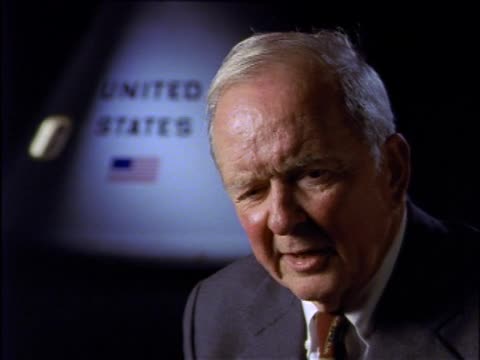NOVA; To the Moon; Interview with Thomas Joseph Kelly, aerospace engineer responsible for working on the Apollo Lunar Module, part 2 of 3
- Series
- NOVA
- Episode
- To the Moon
- Producing Organization
- WGBH Educational Foundation
- Contributing Organization
- WGBH (Boston, Massachusetts)
- AAPB ID
- cpb-aacip-15-7s7hq3t262
If you have more information about this item than what is given here, or if you have concerns about this record, we want to know! Contact us, indicating the AAPB ID (cpb-aacip-15-7s7hq3t262).
- Description
- Program Description
- This remarkably crafted program covers the full range of participants in the Apollo project, from the scientists and engineers who promoted bold ideas about the nature of the Moon and how to get there, to the young geologists who chose the landing sites and helped train the crews, to the astronauts who actually went - not once or twice, but six times, each to a more demanding and interesting location on the Moon's surface. "To The Moon" includes unprecedented footage, rare interviews, and presents a magnificent overview of the history of man and the Moon. To the Moon aired as NOVA episode 2610 in 1999.
- Raw Footage Description
- Thomas Joseph Kelly, aerospace engineer responsible for working on the Apollo Lunar Module, is interviewed about the engineering behind the Apollo program. Kelly talks about his role in the Apollo program and talks about the computer overload during Apollo 11 that triggered issues on the moon and the ground, and forced Neil Armstrong to manually steer the spacecraft with only seconds of fuel remaining. However, there were also issues with the heat exchange on the Apollo 11 spacecraft, which Kelly explains as being caused by a lump of fuel. To fix the issue, Kelly says they "burped the engine" by having the astronauts flick the switch on and off. Kelly talks about the LM and the "spider" and how the astronauts treated it gently, as well as the concerns of the machine, due to its construction. When he first heard that Apollo 13 was having an issue, Kelly was in Boston and was flown down to the Grummon factory, since Kelly's LM was the astronauts' only hope of survival. Kelly had to determine how long the LM could last in terms of oxygen, food, and consumables, and reached out to suppliers all around the country to test the LM's ability to conserve energy.
- Created Date
- 1998
- Asset type
- Raw Footage
- Genres
- Interview
- Topics
- History
- Technology
- Science
- Subjects
- American History; Gemini; apollo; moon; Space; astronaut
- Media type
- Moving Image
- Duration
- 00:23:38
- Credits
-
-
Producing Organization: WGBH Educational Foundation
- AAPB Contributor Holdings
-
WGBH
Identifier: cpb-aacip-c5ba4911d81 (Filename)
Format: Digital Betacam
Generation: Original
Duration: 0:23:38
If you have a copy of this asset and would like us to add it to our catalog, please contact us.
- Citations
- Chicago: “NOVA; To the Moon; Interview with Thomas Joseph Kelly, aerospace engineer responsible for working on the Apollo Lunar Module, part 2 of 3 ,” 1998, WGBH, American Archive of Public Broadcasting (GBH and the Library of Congress), Boston, MA and Washington, DC, accessed December 14, 2025, http://americanarchive.org/catalog/cpb-aacip-15-7s7hq3t262.
- MLA: “NOVA; To the Moon; Interview with Thomas Joseph Kelly, aerospace engineer responsible for working on the Apollo Lunar Module, part 2 of 3 .” 1998. WGBH, American Archive of Public Broadcasting (GBH and the Library of Congress), Boston, MA and Washington, DC. Web. December 14, 2025. <http://americanarchive.org/catalog/cpb-aacip-15-7s7hq3t262>.
- APA: NOVA; To the Moon; Interview with Thomas Joseph Kelly, aerospace engineer responsible for working on the Apollo Lunar Module, part 2 of 3 . Boston, MA: WGBH, American Archive of Public Broadcasting (GBH and the Library of Congress), Boston, MA and Washington, DC. Retrieved from http://americanarchive.org/catalog/cpb-aacip-15-7s7hq3t262
